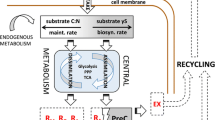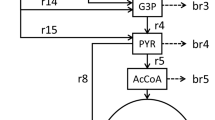Abstract
Soil carbon cycling and ecosystem functioning can strongly depend on how microbial communities regulate their metabolism and adapt to changing environmental conditions to improve their fitness. Investing in extracellular enzymes is an important strategy for the acquisition of resources, but the principle behind the trade-offs between enzyme production and growth is not entirely clear. Here we show that the enzyme production rate per unit biomass may be regulated in order to maximize the biomass specific growth rate. Based on this optimality hypothesis, we derive mathematical expressions for the biomass specific enzyme production rate and the microbial carbon use efficiency, and verify them with experimental observations. As a result of this analysis, we also find that the optimal enzyme production rate decays hyperbolically with the soil organic carbon content. We then show that integrating the optimal extracellular enzyme production into soil microbial carbon models may change considerably soil carbon projections under global warming, underscoring the need to improve parameterization of microbial processes.





Similar content being viewed by others
Code availability
Processed data and the Mathematica code used to draw the Figures is available at https://doi.org/10.4211/hs.7ada4439903f4156be3143e36a9693c7 under a Creative Common Attribution CC-BY.
References
Abramoff R, Xu X, Hartman M et al (2018) The millennial model: in search of measurable pools and transformations for modeling soil carbon in the new century. Biogeochemistry 137(1):51–71
Allison SD (2014) Modeling adaptation of carbon use efficiency in microbial communities. Front Microbiol 5:571
Allison SD, Wallenstein MD, Bradford MA (2010) Soil-carbon response to warming dependent on microbial physiology. Nat Geosci 3(5):336–340
Bachmann H, Fischlechner M, Rabbers I, et al (2013) Availability of public goods shapes the evolution of competing metabolic strategies. Proc Natl Acad Sci 110(35):14302–14307
Bengtson P, Bengtsson G (2007) Rapid turnover of doc in temperate forests accounts for increased co2 production at elevated temperatures. Ecol Lett 10(9):783–790
Brady NC, Weil RR (2016) The nature and properties of soils. Pearson
Chen J, Elsgaard L, van Groenigen KJ et al (2020) Soil carbon loss with warming: new evidence from carbon-degrading enzymes. Glob Change Biol 26(4):1944–1952
Conant RT, Ryan MG, Ågren GI et al (2011) Temperature and soil organic matter decomposition rates-synthesis of current knowledge and a way forward. Glob Change Biol 17(11):3392–3404
Davidson EA, Savage KE, Finzi AC (2014) A big-microsite framework for soil carbon modeling. Glob Change Biol 20(12):3610–3620
Falkowski PG, Fenchel T, Delong EF (2008) The microbial engines that drive earth’s biogeochemical cycles. science 320(5879):1034–1039
Ferenci T (2016) Trade-off mechanisms shaping the diversity of bacteria. Trends Microbiol 24(3):209–223
German DP, Marcelo KR, Stone MM et al (2012) The michaelis-menten kinetics of soil extracellular enzymes in response to temperature: a cross-latitudinal study. Glob Change Biol 18(4):1468–1479
Geyer KM, Kyker-Snowman E, Grandy AS et al (2016) Microbial carbon use efficiency: accounting for population, community, and ecosystem-scale controls over the fate of metabolized organic matter. Biogeochemistry 127(2–3):173–188
Hagerty SB, Allison SD, Schimel JP (2018) Evaluating soil microbial carbon use efficiency explicitly as a function of cellular processes: implications for measurements and models. Biogeochemistry 140(3):269–283
Kallenbach CM, Wallenstein MD, Schipanksi ME et al (2019) Managing agroecosystems for soil microbial carbon use efficiency: ecological unknowns, potential outcomes, and a path forward. Front Microbiol 10:1146
Kleber M, Bourg IC, Coward EK et al (2021) Dynamic interactions at the mineral-organic matter interface. Nat Rev Earth Environ 1–20
Koch AL (1985) The macroeconomics of bacterial growth. Special Publications of the Society for General Microbiology [SPEC PUBL SOC GEN MICROBIOL] 1985
Li C (1996) The dndc model. In: Evaluation of soil organic matter models. Springer, pp 263–267
Li J, Wang G, Mayes MA et al (2019) Reduced carbon use efficiency and increased microbial turnover with soil warming. Glob Change Biol 25(3):900–910
Lipson DA (2015) The complex relationship between microbial growth rate and yield and its implications for ecosystem processes. Front Microbiol 6:615
Maitra A, Dill KA (2015) Bacterial growth laws reflect the evolutionary importance of energy efficiency. Proc Natl Acad Sci 112(2):406–411
Malik AA, Puissant J, Buckeridge KM et al (2018) Land use driven change in soil ph affects microbial carbon cycling processes. Nat Commun 9(1):1–10
Malik AA, Puissant J, Goodall T et al (2019) Soil microbial communities with greater investment in resource acquisition have lower growth yield. Soil Biol Biochem 132:36–39. https://doi.org/10.1016/j.soilbio.2019.01.025
Malik AA, Martiny JB, Brodie EL et al (2020) Defining trait-based microbial strategies with consequences for soil carbon cycling under climate change. ISME J 14(1):1–9
Manzoni S, Katul GG, Porporato A (2009) Analysis of soil carbon transit times and age distributions using network theories. J Geophys Res (2005–2012) 114(G4)
Manzoni S, Taylor P, Richter A et al (2012) Environmental and stoichiometric controls on microbial carbon-use efficiency in soils. New Phytol 196(1):79–91
Manzoni S, Čapek P, Mooshammer M et al (2017) Optimal metabolic regulation along resource stoichiometry gradients. Ecol Lett 20(9):1182–1191
Manzoni S, Capek P, Porada P et al (2018) Reviews and syntheses: Carbon use efficiency from organisms to ecosystems-definitions, theories, and empirical evidence. Biogeosciences 15(19):5929–5949
Martyushev LM, Seleznev VD (2006) Maximum entropy production principle in physics, chemistry and biology. Phys Rep 426(1):1–45
Naylor D, Sadler N, Bhattacharjee A et al (2020) Soil microbiomes under climate change and implications for carbon cycling. Annu Rev Environ Resour 45:29–59
Noda-Garcia L, Liebermeister W, Tawfik DS (2018) Metabolite-enzyme coevolution: from single enzymes to metabolic pathways and networks. Annu Rev Biochem 87:187–216
Nottingham AT, Meir P, Velasquez E et al (2020) Soil carbon loss by experimental warming in a tropical forest. Nature 584(7820):234–237
Parton W, Schimel DS, Cole C et al (1987) Analysis of factors controlling soil organic matter levels in great plains grasslands. Soil Sci Soc Am J 51(5):1173–1179
Paul E (2014) Soil microbiology, ecology and biochemistry. Academic Press
Ramin KI, Allison SD (2019) Bacterial tradeoffs in growth rate and extracellular enzymes. Front Microbiol 10:2956
Roach TN, Salamon P, Nulton J et al (2018) Application of finite-time and control thermodynamics to biological processes at multiple scales. J Non-Equilib Thermodyn 43(3):193–210
Sanderman J, Hengl T, Fiske GJ (2017) Soil carbon debt of 12,000 years of human land use. Proc Natl Acad Sci 114(36):9575–9580
Schimel J (2001) Biogeochemical models: implicit versus explicit microbiology. In: Global biogeochemical cycles in the climate system. Elsevier, pp 177–183
Schimel JP, Weintraub MN (2003) The implications of exoenzyme activity on microbial carbon and nitrogen limitation in soil: a theoretical model. Soil Biol Biochem 35(4):549–563. https://doi.org/10.1016/s0038-0717(03)00015-4
Sihi D, Gerber S, Inglett PW et al (2016) Comparing models of microbial-substrate interactions and their response to warming. Biogeosciences 13(6):1733–1752
Singh BK, Bardgett RD, Smith P et al (2010) Microorganisms and climate change: terrestrial feedbacks and mitigation options. Nat Rev Microbiol 8(11):779–790
Sinsabaugh R, Moorhead D (1994) Resource allocation to extracellular enzyme production: a model for nitrogen and phosphorus control of litter decomposition. Soil Biol Biochem 26(10):1305–1311
Sinsabaugh RL, Manzoni S, Moorhead DL et al (2013) Carbon use efficiency of microbial communities: stoichiometry, methodology and modelling. Ecol Lett 16(7):930–939
Smith P, House JI, Bustamante M et al (2016) Global change pressures on soils from land use and management. Glob Change Biol 22(3):1008–1028
Sulman BN, Moore JA, Abramoff R et al (2018) Multiple models and experiments underscore large uncertainty in soil carbon dynamics. Biogeochemistry 141(2):109–123
von Stockar U (2013) Biothermodynamics: the role of thermodynamics in biochemical engineering. PPUR Presses polytechniques
Wei X, Shao M, Gale W et al (2014) Global pattern of soil carbon losses due to the conversion of forests to agricultural land. Sci Rep 4(1):1–6
Westerhoff HV, Hellingwerf KJ, Van Dam K (1983) Thermodynamic efficiency of microbial growth is low but optimal for maximal growth rate. Proc Natl Acad Sci 80(1):305–309
Wieder WR, Bonan GB, Allison SD (2013) Global soil carbon projections are improved by modelling microbial processes. Nat Clim Chang 3(10):909–912
Wieder WR, Allison SD, Davidson EA et al (2015) Explicitly representing soil microbial processes in earth system models. Global Biogeochem Cycles 29(10):1782–1800
Acknowledgements
We gratefully acknowledge support by the Department of Biological and Agricultural Engineering and AgriLife Research at Texas A&M University, and the USDA National Institute of Food and Agriculture.
Funding
This work was supported by the Department of Biological and Agricultural Engineering and AgriLife Research at Texas A&M University, and the USDA National Institute of Food and Agriculture, Hatch project 1023954 and multi-state Hatch Project W-4188.
Author information
Authors and Affiliations
Contributions
Conceptualization: SC; Methodology: SC, BM, AAM; Formal analysis and investigation: SC, BM, AAM; Writing - original draft preparation: SC; Writing - review and editing: SC, BM, AAM. Funding acquisition: SC.
Corresponding author
Ethics declarations
Conflict of interest
The authors declare no conflicts of interest.
Additional information
Responsible Editor: Justin B. Richardson.
Publisher's Note
Springer Nature remains neutral with regard to jurisdictional claims in published maps and institutional affiliations.
Rights and permissions
About this article
Cite this article
Calabrese, S., Mohanty, B.P. & Malik, A.A. Soil microorganisms regulate extracellular enzyme production to maximize their growth rate. Biogeochemistry 158, 303–312 (2022). https://doi.org/10.1007/s10533-022-00899-8
Received:
Accepted:
Published:
Issue Date:
DOI: https://doi.org/10.1007/s10533-022-00899-8




